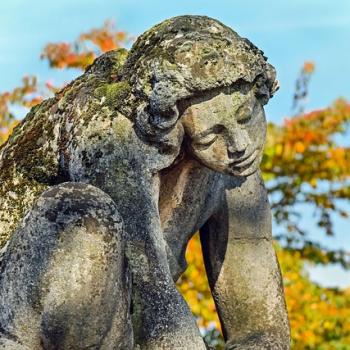Thus many early Jews would have seen John's baptism in light of this ritual purification of the mikveh, and would have seen it linked in some way to preparation for entering the temple, perhaps in preparation for the eschatological purification of the temple itself. Josephus, writing in the late first century, describes John's baptism as a "purification of the body" (Antiquities, 18.117), probably reflecting this standard Jewish perspective. Thus, immersion was a necessary purification ritual for entering the temple, and, as we shall see next week, the first public act of Jesus after his immersion/purification by John was entering and purifying the temple (Jn. 2:13-25).
Immersion purification was also required by gentile converts to Judaism, a practice that would have been known to first-century Jews. There is also evidence of sectarian immersion rituals within Judaism, that is, an immersion ritual as a sign of joining a sub-group or denomination within Judaism. This is especially clear in the Qumran community, where repentance and ritual immersion were required of people wishing to join the community. This has led some scholars to speculate about a possible relationship between John the Baptizer and the Qumran community, though these parallels may simply reflect a shared set of religious assumptions. Be that as it may, it is clear that the idea of immersion as a purification ritual associated with either a gentile joining Judaism, or a Jew joining a Jewish sectarian movement would have been familiar to John's Jewish readers of the first century.
John's immersion ritual, though it follows these broad patterns, was nonetheless distinctive in certain aspects. First of all, John in some way performed the baptism. It is not clear exactly how this was done, but the people were baptized by John; they didn't just immerse themselves. John's baptism was not merely purification of the body so that the candidate could enter into the presence of God in the temple, though this was, of course, part of what was going on. John's immersion ritual went further. It was intended to purify the body so that the body became a proper receptacle for the presence of God through immersion in the Spirit. This is precisely what is described on a number of occasions in Christian baptism, Jesus' baptism being the most famous example. Thus, when John says "he [God] who sent me to immerse with water said to me: ‘He on whom you see the Spirit descend and remain, this is he who immerses with the holy Spirit [of God]'" (Jn. 1:33), he is saying that he immerses with water to purify the body so it can be immersed in the presence of God as manifest by the Spirit, even when outside the temple. John is thus taking temple purification ideology of the mikveh one step further. You are not purified so that you can enter the presence of God in the temple—as standard Jewish mikveh theology would have it—but you are purified so the presence of God can enter into you.
According to the synoptic gospels, John's baptism required repentance as a prerequisite (Mt. 3:8-11; Lk. 3:8). It was a "baptism of repentance for the forgiveness of sins" (Mk. 1:4; Lk. 3:3). John, however, does not mention repentance as an aspect of John the Immerser's ritual. (Indeed, John never uses the term "repent" at all in his Gospel). This does not necessarily mean that it wasn't a part of the purpose of immersion, but John the Evangelist wants to emphasize something else.
Then why does John baptize? John baptizes first simply because God commanded him to (1:33), but, more importantly: "for this purpose I came baptizing with water, that he [Jesus the Messiah] might be revealed to Israel" (1:31). How does John's immersion ritual reveal that Jesus is the Messiah? First, when Jesus comes to John for baptism, John receives the witness of the special sign he had been promised from God: "He on whom you see the Spirit descend and remain, this is he who immerses with the Holy Spirit" (1:33). John's (implied) water immersion of Jesus prepares the way for Spirit's immersion of Jesus, which reveals him as the Messiah to John, as prophesied by God. Furthermore, water immersion of disciples likewise reveals Jesus as the Messiah. The disciple is immersed in water (John's baptism) for temple-style purification in preparation for the immersion in the Spirit (Jesus' baptism). The Spirit will then reveal to the baptized disciple that Jesus is the Messiah (3:5-6, 14:17-16, 15:26).
Bethany across the Jordan
John is said to have baptized in "Bethany across the Jordan" (1:28), not to be confused with the Bethany near Jerusalem where Lazarus and Mary dwelt (12:1-8). There is a variant reading at this point between the older and widely attested Bethany, and Bethabara, which is found in the Textus Receptus (the Greek New Testament as it came to Western Europe in the 15th century), and hence in early English translations such as the King James Version. All other references to Bethany in the New Testament are to Lazarus's city near Jerusalem. In Aramaic Bethabara means the "house/place of crossing," in other words, a ford across the Jordan river. It is obviously not a textual error, but an alternate name. (It may be that Bethabara was the name of a ford, and Bethany was a village nearby.) Bethabara can be seen on the 6th-century Byzantine Christian Madaba map, and was the location of a major Christian church and baptismal site on Byzantine Christian pilgrimage itineraries (4th through 7th centuries). This site was recently excavated and can now be visited in Jordan (see photos).





